|
FAQs about Faviid Coral Disease Diagnosing
FAQs on Faviid Disease:
Faviid
Disease 1, Faviid Disease
2, Faviid Disease 3,
Faviid Disease 4, Faviid Disease 5, Faviid Disease,
FAQs on Faviid Disease by Category:
Environmental (Pollution/Poisoning, Lighting...),
Nutritional, Social (Allelopathy),
Trauma,
Pathogenic (Infectious, Parasitic, Viral)
Predatory/Pest, Treatments
Related Articles:
Coral Pests and Disease; pests, predators, diseases and conditions by Sara
Mavinkurve,
Faviid
Corals,
FAQs on Stony Coral Disease: Stony Coral Disease 1, Stony Coral Disease 2, Stony Coral Disease 3, Stony Coral Disease 4, Stony Coral Disease 5, Stony Coral Disease 6, Stony Coral Disease 7, Stony Coral Disease 8, Stony Coral Disease 9, Stony Coral Disease 10, Stony Coral Disease 11, Stony Coral Disease
12, Stony Coral Disease 13,
Stony Coral Disease 14,
Stony Coral Disease 15, Stony Coral
Disease ,
FAQs on Stony Coral Disease by Category: Diagnosing:
Environmental (Pollution/Poisoning, Lighting...),
Nutritional, Social (Allelopathy),
Trauma,
Pathogenic (Infectious, Parasitic, Viral)
Predatory/Pest,
Treatments
FAQs on Stony Coral Disease by Type: Brown Jelly Disease, RTN,
|
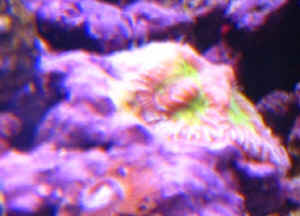
|
|
Trumpet Coral Problem 10/1/15
Dear Wet Web Media,
<Wendy>
I am having a massive loss of yellow trumpet coral and looking
for ideas as to why.
<Will give you the principal sources: predation, environment (ho boy), lack of
nutrition, allelopathy....>
All other fish (6 small), various hermit crabs, snails, starfish, anemones (5
keep splitting)
<Mmm; near by?>
and corals
<See you've listed these below; good>
are acting normally.
165 gallon
4 years old system
Aqua C EV skimmer/LEDs/co2 reactor/refugium/wave maker
SG 1.025, 79-81.5 F temp, Alk 10-12, Calcium 435, magnesium 1340, 0
nitrates, 0 phosphates,
<Ooops! Here's at least part of the "issue"; a lack of N, P, K.... READ here:
http://www.wetwebmedia.com/FavNutrDisF.htm>
20% water changes weekly
<And you dose iodide/ate then?>
The tank has few SPS (birds nest, much monopora), many LPS (frogspawn,
plate, chalice, brain), and 2 large soft corals (toadstool leather and
Sinularia), a couple mushrooms, Ricordeas and some Zoanthids.
<Again; allelopathy is a concern here as well... some of the more chemically
aggressive organisms you have can/do poison other Cnidarians distally at times;
esp. ones that are otherwise compromised (starving in this case)>
No new corals have been added, all have been thriving. I do have a bright yellow
encrusting sponge that I am trying to keep under control.
<This might be a contributor as well>
The trumpet corals have been growing like crazy. I started out with 2 heads
eight years ago and now have 300+ and have traded away 100+.
<Ah, good>
Anyhow, I was gone on vacation (1 week) and think the tank care giver was
feeding too much. (pellets and rinsed frozen food) Upon my return phosphates
were too high, so immediately I did water changes and added PhosBan media to an
extra media reactor I had in my LifeReef sump.
Phosphates were 0 in a few days.
<.... all chemo-photosynthetic life needs measurable soluble HPO4>
Soon after, I lost 2 trumpets (tissue recessed from bottom until dead
in few days). I assumed it was a freak out from phosphate elevated.
<Actually; the opposite>
Well, it's been a month and now the trumpet loss is epidemic, as I have 25% of
the trumpet heads dead or in recession. I have continued to care for the tank as
usual, testing is fine and good water changes. I see no critters on any corals.
What else can I do?
<The I2 mostly; multiple dosed; as you'll find in your reading; removal of the
chemical filtrants...>
I am not even sure the loss is due to a fluctuation in phosphate...?
Should I remove all dead heads and recessing heads or wait it out?
<I'd leave all in place>
Should I do a lugos dip on all trumpets colonies?
<Better to add to the system itself>
What other tests can I do?
<How much time do you have to read?>
Why would only the trumpets (which are spread all over the tank, up and down and
middle) be receding and dying?
<They're on the "losing" side of allelopathogenic "strength" here, and more
susceptible to nutrient deficiency>
Thanks so much! Really, thank you very much for your advice.
Wendy
<Cheers, Bob Fenner>
|
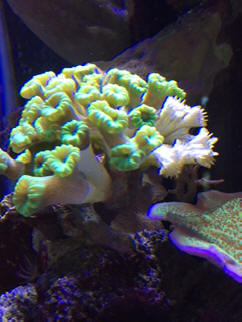 |
|
Favia Has Blister – 09/25/14
I have a Favia about one year that has been growing nicely. This morning
I noticed an area about 20mm in diameter that has a blister. The soft
tissue has separated from the skeleton. It looks like a boil that
fluctuates in the current from a wave maker.
<<Indeed…and have seen this with my own Favia coral>>
Yesterday I did change my GFO and carbon. Parameters are perfect and I
am growing Acropora with ease in this system. I have attached a photo
showing the coral in question.
<<I see this>>
The lesion is on the right side at about the 1:00 O'clock position. Any
help would be appreciated.
<<As noted, I have experienced this phenomenon in my own system. The
“blister” may be a result of physical trauma (picked at by a
fish/crustacean or stung by another coral)…or maybe it’s even a sign of
a reproductive event (just guessing here). But in my case, it turned out
to be of no worry. I actually ‘popped’ the blister on my Favia coral. It
came back within a week or two…I popped it again, and this time the
coral healed and returned to its normal appearance. Not saying this is
what you should do, but is something to consider. You could also try a
dip in something like Tropic Marin Pro Coral Cure. Aside from this, I
would simply leave the coral be for now and observe>>
Thank you.
Karl
<<Happy to share… EricR>>
|
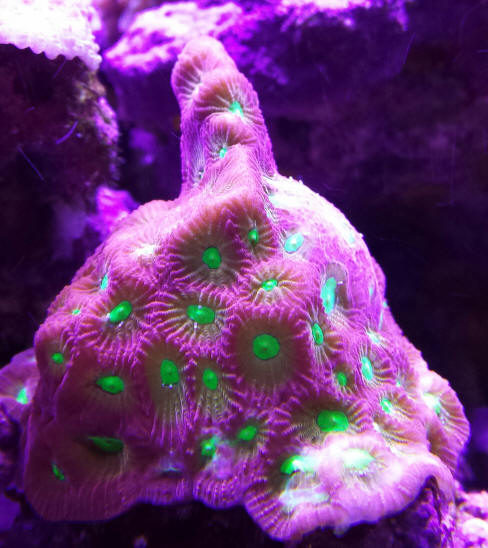 |
|
Re: Favia Has Blister
09/25/14
Thank you Eric for your prompt response!
<<Quite welcome, Karl>>
I cannot remove the coral for dipping as it long ago spread from its
original plug to the rockwork.
<<Okay…should still be fine>>
I do not believe that it was a fish as all my fish are completely reef safe
(That includes any that are considered reef safe "with caution".) I don't
believe it was stung by another coral but I will check tonight to see if any
sweepers come anywhere near it.
<<Then likely these are not the cause of this phenomenon (as was the case
with my own issue re). I’m reluctant to call this a “complaint” as it may
well be a “normal condition” of these animals>>
I will probably pop the "blister" and will keep you informed.
<<Sounds good mate>>
Again, my sincere "thanks".
Karl
<<Always welcome… EricR>>
RE2: Favia Has Blister 10/22/14
Hi Eric,
<<Hey Karl>>
Just a follow up on the Favia as promised.
<<Great!>>
There has been little change. The involved area remains constant. No sloughing.
Sometimes it lies flat on the skeleton and at other times it blows up. Aspirated
two times, will just observe. If there are changes I will advise. Thanks for
your help.
Karl
<<Thanks for the update… You could try excising the loose tissue with a sharp
blade (Exacto/razor)…or if not that bothered, leave as is. Cheers mate…EricR>>
RE3: Favia Has Blister 11/19/14
Hi Eric,
<<Hi Karl>>
In follow up, the area involved has begun to slough exposing coral
skeleton in some areas. Some algae in these areas is noted. I suspect
that the entire blistered area will be lost.
<<Likely so, yes>>
Hopefully, new tissue will grow in from the periphery. Will take many
months.
<<If water quality is maintained and the coral is receiving adequate
light, flow, nutrition, et al…it is very likely to recover, in my
experience/estimation>>
I will inform you of the progress.
Karl
<<Cheers mate…EricR>>
RE4: Favia Has Blister ¬ 10/15/15
Hi Eric,
<<Hey Karl>>
The area has completely healed and filled in. Thanks.
Karl
<<And thank 'you' for the update…Cheers, EricR>>
|
|
Candy Cane Woes?
11/4/10
Hi All-
<Hello Sal>
Been awhile, but I thought I'd let you know what's doing.
I had a little back-n-forth with Scott regarding clowns awhile
ago. I had good success, and the little buggers are 5 months old
(pic attached).
<Well done>
I'm selling them privately. Besides $$ for clowns, I got a
nice candy cane frag as barter from a friend (also, pic
attached). I propped it up on a piece of rubble, but one of my
snails kept knocking it over. So, I pulled it out and wrapped a
rubber band *once *around the "cane" and many times
around the rock. In the process, because my hands were wet and
the coral was covered in mucus, it fell out of my little gloved
hands and onto the floor. Yes, it broke, but fortunately it was a
clean break at the base of a branch. I then
finished my rubber band binding, rinsed it off in fresh seawater,
and replaced the larger piece. I stuck the "base" of
the smaller piece into a hole in a chunk of base rock. Took a day
to "regroup", but it looked fine for 2 weeks.
<Ok, fine so far>
Now, it looks like the green fleshy (polyp?) part is tearing
up.
<Mmm, the file sizes on your pics are far too large for me to
open, so I am replying 'blind' here.. this could be a
polyp bailout, or the coral dying>
It is still opening up and closing, and it is still eating
(target feeding of microgack, yum!) I've never had one of
these before -- is it dying or is it growing?
<Posted>
Water quality is good: pH=8.2, Ca=400, dKH=11.
<Nitrates? Mg? Temp? Salinity?>
I dose 10mL of SeaChem's Reef Plus into a 55g twice a week
(just less than half recommended dose) for trace elements.
<Mmm, not a fan of these products at all>
It's been a very long time since I've had to add
chemicals to maintain ionic balance. I took a look on the site,
but I didn't find anything to answer my question. Could be I
didn't look deep enough?
<Could be'¦ all you can do is keep feeding the coral
and keep the water quality up. It may recover, if bailing out it
may re-grow a new skeleton, or it may not.>
Many thanks,
-Sal
PS - Please let Bob know I've instituted a Catch-And-Release
program for worms -- only the "bad" ones get relocated;
the "good" ones get released back onto the reef ;)
<?? You should never, ever release animals from your home
aquarium back to the reef, you can and will introduce non-native
species that can have devastating consequences on wild animals.
Simon>
<<He's
joshin' ya here Simon. B>>
|
|
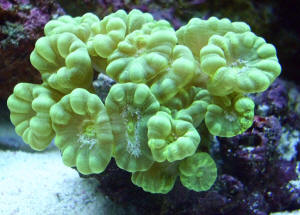
|
Re: Candy Cane Woes? 11/5/10
Hi Simon-
<Hi Sal>
Resending smaller pics. Sorry about that.
<No problem, and well done on the Clowns!>
I want to send another pic of
the two frags so you can see how they're pulling away from the
calcified stalks.
<Mmm, the white strings look like mesenterial filaments to me..a
reaction to something, either chemically or another animal.>
I'll to do that later (at work now), but I did read a few
articles on WWM regarding bailout (including pics) and I'm not
*sure* that's what it is.
<looking at your picture, neither am I>
It does look as though the design of this animal dictates the
polyps must split in order to accommodate a branch.
<Yes, and perhaps that is what you are seeing, but this is not
usually associated with mesenterial filaments>
I have a variety of soft corals, zoos, and mushrooms. <Ahhh! The
likely culprits here.. allelopathy>
All of these are at a good distance and doing fine.
<Yes but sharing the same water system>
I don't test Mg; perhaps I should. <yes> My temp sits at
79-80, and my SG hangs at 1.024.
<Would raise this one notch>
I would like to get them lower, but try as I may I can't get my
NO3 lower than 20ppm.
<For Scleractinians this wants to be less than 10. Are you
testing your source water?>
This tank's been up for 2 years, and since it first cycled it
has never had any NH4, NO2, or PO4.
<Does need a trace of this last>
I use DI only.
<RO?>
BTW, by "Catch-And-Release" I meant releasing worms back
onto the reef in my tank. Bob would be pleased. I'm sorry if my
words led you to believe I meant otherwise.
<Ahh, understood and well done, I like worms in my reef
too!>
Thanks again,
-Sal
<Simon> |
|
Re: Candy Cane Woes? 11/10/10
Hi Simon-
<Hi Sal>
Thanks for the commentary. Allelopathy! Could be -- skimmer's
been working overtime lately, but the snails have been spawning
so it's hard to tell.
Very likely those filaments were a reaction, as that photo was
taken the day after I got the coral (Oct 17).
<Yes>
I took some pics last night as close up as I could. You can see
the filaments retracted. I appreciate how you might consider
another animal, but what? Parasite?
<The toxic softies that you are keeping -- 'mushrooms'
et. Al. These are animals>
They guy (Kenny) who gave it to me says the mother grows like a
weed. You can see what looks like stalk extension in #387 on the
big piece. The "break" is way down at the bottom of
this piece, very close to the stalk. The best shot of the
partitioning is in #388, on the small frag, but you can also see
it on the bigger frag in #389. I've checked the logs, and I
have had a little PO4 trace now and then, but nothing to worry
about.
<ok>
I can move the mushrooms further away (down-current, I presume?)
if you think that will help, but Kenny has a ton of them.
<Different systems and their maintenance/ set up can/ will
have different effects on many things. Can you say that your
system is identical in every way to your friends? Likely not.
Running some carbon might help somewhat here>
I will raise my salinity to 1.025, per your suggestion, and get a
test for Mg. Where should that be, ideally, and what products do
you recommend that work to adjust it?
<Mmm, about three times that of your calcium, something like
1200ppm. How to maintain this depends how large your system is,
it's needs/ wants. Best to research this on WWM, perhaps look
for articles by Randy Holmes Farley on the web. Your coral is
Scleractinian however, and maintenance of Mg is required
here>
Also, in terms of water... I don't do RO -- DI only.
My tap water has NO3 of about 8ppm, and the DI filter removes all
of these.
<Perhaps investing in a true RODI unit might help you
here'¦ will certainly be better than DI only>
As always, much appreciated. Have a great weekend,
<You too Sal, and happy reefing!>
-Sal
<Simon>
|
|
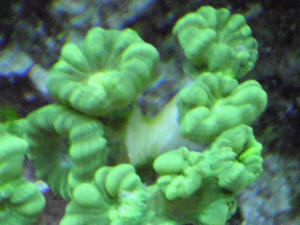
|
|
Re: Candy Cane
Woes? 11/11/10
Hi Simon-
<He's "marked out" for a while>
Oh, boy... where to start?? Yesterday, I discovered my cucumber
got himself sucked up into the filter. FORTUNATELY he didn't
turn out his innards. It could have been worse. Anyway...
Likely, even two "identical" systems will react
differently because Life is unpredictable. I do run carbon all
the time, actually (old school) so I'm ahead of that game. I
don't think it's the mushies, but rather, from the look
of the canes, I think the coral is actually growing. The torn
polyp flesh appears to have reattached itself, and at least one
crown has experienced a division into two distinct polyps.
Apparently, no cause for alarm -- Sal jumped the gun ;)
<Happens>
I am concerned about your suggested Ca level, however. My friend
doesn't keep his anywhere near 1200. He hovers at 500, which
is not far above my level of 400-420.
<Mmm, the 1,200 value doesn't exist. Your stated range is
fine>
He also doesn't do anything with his Mg level.
<Many folks don't... and this is a mistake. Read here:
http://wetwebmedia.com/mgmarfaqs.htm
Like myself, he's no authority, but he does what his son
tells him. His son was the manager of the largest LFS in the
area, and Kenny says he never mentioned Mg.
<Again...>
I went to 3 separate LFS, nobody has an Mg test. I went back to
mine. My LFS guy says they don't stock Mg test kits, but
he'll be happy to order one for me.
<This or the etailers/Net>
The reason he doesn't stock them is, they are very
expensive,
<Not. The Sera, Salifert, other brands are a few tens of
dollars>
nobody buys them, and they expire quickly. Then he asked about my
sudden interest in Mg levels, so I told him about this thread. He
said he doesn't do anything about Mg, either, and keeps his
Ca levels at 600 in his reef tank at home.
<Ludicrous... won't happen w/ adequate KH present. Please
learn to/use the search tool on WWM ahead of writing us. Read
here: http://wetwebmedia.com/calcalkmar.htm
and the linked files above>
He's got a lot of Acros and 2 Candy Canes, all of which grow
like weeds.
I'm going to ask one of the guys at the Lab if he'll run
a water sample through the mass spec for me. Obviously, this is
not something I can do on a regular basis, but it will give me an
accurate reading of all traces, including Mg. I may pick up a
test if I can find one online. While I can't justify it based
on the experience of my peer reef keepers, I do respect your
advice as an expert in this area and want to do the right thing
for my animals.
<See Dr.s Foster & Smith, Marine Depot (.com)... for this
kit>
Thanks much,
-Sal
<Welcome. Bob Fenner>
Re: Candy Cane Woes? 11/11/10
Hi Bob-
<Hey Sal>
Nice to "see" you again. I thank you for the advice. I
think I over-reacted on this one. I went back and read *all* the
emails from Simon -- methinks a misunderstanding happened on my
part and he meant *Mg* should be 1200, not Ca.
<About three times Calcium concentration is right>
This has been the source of my confusion with this thread. Also,
apologies for my typo: My LFS guy keeps his Ca at 500, not
600.
<Still too high IMO>
I am happy report my Mg is at 1247ppm as determined by mass
spectrometer. I also found a Salifert test on Marine Depot which
I'll pick up eventually; thanks for the heads up.
<Welcome>
Regarding the search tool on WWM: I do use it, and very often.
However, in a case where something as specific as this is
concerned, Google doesn't do a good job of returning only
what you want to see.
<Ah yes... do use the search tool that renders the
"cached view"... Much easier to see/find
highlighted/key words>
Be well.
-Sal
<Am trying my friend. BobF>
|
Trumpet/Candy Cane Issues, hlth., data --
09/09/10
Faviids Losing Tissue/Colored Skeletons --
05/17/10
Hey guys,
<<Paul>>
I have searched and searched and can't find any info on this issue
I am having.
<<Okay>>
I lost a Joker's Favia (purple and green) a few weeks ago and
basically the skin on the Favia just started to pull back from the
base, exposing the skeleton and in a week or so, was totally gone.
<<Mmm, most such events are related to water
chemistry/quality'¦in my experience>>
The skeleton was a bright red/pink color. Even after two weeks, the
skeleton stayed red/pink.
<<I have heard musings as to the reason why some Acropora
skeletons are 'green' at the time of tissue loss (infestation
of a boring alga species) which I suppose could apply to 'any'
hard coral species, but I have not heard about red/pink
skeletons'¦though if these theories are accurate, it could
be about any 'color' depending the alga involved'¦or
maybe it is the result from a microbial infection>>
Now it is happening to a Sponge Bob Favia (yellow and green). Both were
on the sand,
<<This may be adding to the problem if the sand is shifting and
causing tissue recession that might open avenues for bacterial
infection. Though many people do place these animals on sand, they are
generally not 'free living' organisms designed for such but
were likely broken from a hard substrate'¦placement on such
in the aquarium would be best, in my opinion>>
30" below the surface of my 300 gallon tank. The lights are 400W
MH with 12K ReefLux bulbs.
I have tried dipping the corals in Tropic Marin Coral cure with no
luck.
<<As long as any environmental issues causing the problem are not
identified and corrected, this would not help>>
Are Favia skeletons just red in color?
<<Have all been white, in my experience>><Are white...
though could be algal, bacterial coloring being added here once the
tissue is gone. RMF>
A few of my micros and Acans are receding as well but they are leaving
white skeleton behind.
My parameters are; temp 75.1*, pH 8.0 probe, 8.1,
<<'¦?>>
Seachem ammonia 0, nitrite 0, nitrate 30
<<High'¦ This very well may be the cause for the
tissue recession>>
(I feed heavy)
<<As do I, but you must employ means to keep Nitrate under
control (DSB, vegetable refugium, ancillary chemical filtration,
aggressive skimming, etc.)>>
KH 3.5 mEq/l or 9.8 dKH, Ca 440, Mg 1300, SG 1.024. I did a 50 gallon
water change on 12 May. Any ideas?
Paul Murphy
<<As stated'¦ There may be other contributing factors
(e.g. - placement), but based on your Nitrate reading I'm inclined
to think this is a matter of water quality. Cheers, EricR>>
Re: Faviids Losing Tissue/Colored Skeletons --
05/18/10
Eric,
<<Paul>>
Thanks for the reply.
<<Quite welcome>>
I tested water again today, with a new kit and nitrates are only 10ppm,
not 30 like the old kit was indicating.
<<Ah, a common issue'¦and much better>>
I will move the Sponge Bob up and hope it recovers. I dipped it again
yesterday.
<<I would still look at improving water
quality'¦perhaps adding some Poly-Filter chemical media to
the filter flow path. Cheers'¦ Eric Russell>>
Unhappy Chalice Corals - Need Help -- 09/30/09
Dear WWM Crew,
<<Hello Laura>>
I have an 85 gallon reef tank with excellent water parameters
<<Real values please'¦>>
and one 150 HQI Metal halide bulb with 2 VHO 96 watt bulbs. I recently
ordered via mail (from a very reputable resource) two Echinopora
chalice corals.
<<Ah yes, a very popular coral'¦with some crazy
colors/color combinations to be found>>
They were beautiful upon arrival and I placed them mid level in my tank
on an open ledge of live rock,
<<Mmm'¦best to place these in a 'less bright'
location. Once acclimated to it they 'can' take the bright
lighting'¦but would still probably do/look better if
it's a bit more 'subdued' than what's received
mid-level in the tank under that MH bulb>>
where nothing could bother them.
<<Except maybe each other'¦ These are very aggressive
corals>>
This was two weeks ago, and they have been declining ever since.
<<Possibly photo-shock'¦or fighting amongst themselves
if placed to close together (this would be happening after tank
lights-out)>>
I am seeing tissue recession on the edges of the corals, as well as
both of them constantly struggling to "puff up" and then
deflate to show skeleton through their tissue. They look quite unhappy,
and I am very anxious to get them back to a healthy state. I feel they
are extremely 'stressed" and yesterday, I moved them to the
bottom of my tank under a live rock ledge that has lower, more filtered
lighting. I have been target feeding them with live phyto,
<<These are carnivorous animals>>
Cyclopeeze,
<<A good food choice here>>
and "Restore", a product for tissue regeneration containing
amino acids and HUFA's by Brightwell Aquatics.
<<Hmm'¦ Admittedly I'm not familiar with this
particular product from their line'¦ But I would suspect
direct supplementation with a proven quality food additive like
'Selcon' to be better money spent>>
The eyes open when I do this and they appear to take in food.
<<Absorption feeding is a possibility'¦but these
corals generally feed with the use of feeding tentacles'¦and
unless trained otherwise, is again an 'after lights-out'
event>>
They also appear to be expelling waste as a healthy animal would. As if
the stress of shipping were not enough for these poor animals, a
lighting change was made to my tank a few days into their arrival from
T5 lighting to the aforementioned MH and VHO set up.
<<Oooh'¦.likely part of the problem here>>
This was poor timing on my part, but the chalices were already showing
signs of being unhappy
<<But still'¦couldn't have helped>>
- primarily the recession and the puffing up and deflating I have
described. What else can I do to help these guys along and recover?
<<It's possible these corals were somehow malaffected before
you received them. These corals are fairly undemanding (once
acclimated). But'¦ Try placing them lower in the water
column and a bit to the side of the MH bulb 'and make sure
there are a few inches between them to preclude physical aggression.
Allelopathy is another possibility depending on your other livestock so
adding/beefing up carbon filtration (and/or Poly-Filter) may be of
benefit here>>
Also, will the tissue regrow over the edges that show recession if the
corals can be brought back to health?
<<Yes'¦ Should they recover, the corals will
regenerate that 'rolled-edge' look and grow over the old
skeleton much like any other hard substrate>>
I would appreciate any suggestions you can offer me.
<<I've made a few 'there's really not much
else you can do save move them to another system, to see if this makes
a difference>>
They are very beautiful and there is still a lot of healthy tissue on
them if they were to "bounce back."
<<If you can determine what is bothering these corals (too much
light 'too close together/too other aggressive corals) and
make a correction 'there's a good chance they can
recover>>
Thank you so much,
Laura
<<Happy to assist'¦ EricR>>
Re: Unhappy Chalice Corals - Need Help --
10/01/09
Dear Eric,
<<Hey Laura!>>
I apologize for the lack of water parameter information on my tank, and
I also noticed I forgot to include that I use a 14K Hamilton HQI MH
bulb in the lighting information.
<<It is best to give us as much info as possible (thank you for
this). You never know where a 'clue' might be
hiding>>
Water parameters are:
Ca: 450
dKH: 10
Temp: 78F
Phosphates: Undetectable
Nitrate: 0
Ammonia: 0
Magnesium: 1395
Salinity: 1.024
pH: 8.1-8.2
<<And agreed, no real problems here'¦ though I would
let either the Calcium or Alkalinity fall just a bit. Have you read
this? http://www.wetwebmedia.com/calcalkmar.htm>>
I do run carbon on the tank.
<<Excellent>>
The chalices do have several inches between them, the closest animal to
one being a crocea clam on the sand bed of the tank, now that I have
moved them to lower positions. This clam is several inches from the
chalice.
<<Okay'¦ But do try to observe the corals at different
times after the tank has been dark to make sure they are 'far
enough' apart. You might be surprised at their
'reach'>>
This morning the chalices appear to be "stable". Although I
am no expert,
<<Me neither! [grin]>>
I am suspecting lighting to be my biggest issue in their state of
health.
<<I too think that to be a contributing element here>>
Just out of curiosity, how long in the more subdued lighting would they
need to reside before I would see marked improvement if, this is
indeed, their issue?
<<Hmmm'¦ Based on your previous statements re, I would
expect to see improvement in as little as a week (flesh filling
out/expanding, color returning)'¦though it may take a while
(several weeks or more) to notice any 'significant' regrowth
over the damaged margins>>
This will be their second day in the dimmer lit area. I also have
Selcon and can begin using that product since it seems to be a proven
enrichment product for captive animals.
<<Indeed'¦ Do also look in to/get some New Life
Spectrum pelleted food. Aside from the benefits of this excellent
prepared food to your fishes, consider that it can also be fed to your
Chalice corals 'as well as Faviids, Euphyllids, and others
with similar feeding structures/tentacles/methods. I find the 1mm
pellets to work well all around>>
Thank you so much for all of your help!
Laura
<<Always happy to share'¦ Eric Russell>>
Candy Cane Coral Problem 7/22/08 Good morning all,
<Shawn> I have gone over your website trying to find something
regarding my problem but could find nothing. My problem is that my
Candy Cane Coral has been doing great up until the last few weeks. It
has been changing colors around the edge. <Mmm, any changes to your
system?> The inside has remained the same green color but the outer
edge has been turning a lighter fluorescent green to almost yellow. All
else seems to be ok with them except that color change. All water
checks were very good with the exception of ph was a little low, 8.0. I
do 15% water changes every 2 weeks. Might this be a normal color change
or could it be something more serious. Any help you can give would be
greatly appreciated. Thanks in advance, Shawn <... Could be an
influence... but feeding, light changes (are your lamps getting old?),
water quality, a lack of phosphate/useful phosphorus, nitrogen... many
other possibilities exist. Please read here:
http://wetwebmedia.com/faviiddisfaqs.htm and the linked files above.
Bob Fenner>
|
Caulastrea... Improvement related to ? 9/26/07 Hi Crew,
<Greetings Mich here.> I have this Caulastrea for a few
months. I was told it was a candy cane but it is not. <Candy
cane is a common name used for Caulastrea.> I did find a
picture of what I think it is but I cannot remember what it was
called. <Looks like Caulastrea to me.> The skeleton poked
through in a few place but it stayed like that for a couple
months. <Yikes!> The whole top looks like it is flesh the
same as each head. It looks like it is brown underneath with a
see through cover that is bluish. The mouths are blue. It opens
at night like candy cane but not as often and not all the heads
open. <Still think this is Caulastrea.> It was in the front
corner in a 10-gallon with 65w power compacts. <Small
system.> I do not feed anything other than what I give my
fish. <It would likely benefit from supplemental feedings.>
Tank is about 4 years old. As you can see to the right is a candy
cane and behind it there is a mushroom. <Yes, I see.> All
of a sudden the flesh started retracting from the body and the
heads. <I am wondering how your calcium levels are.> I
moved it to the back corner where it gets the same amount of
light. The one difference is that before it was on the sand on
now it is on a small rock. It seems to be making a comeback after
a few weeks being there. A few of the heads have a lot of flesh
on them, more that they ever had since I have this piece. Can
being on a rock instead of sand make that much of a difference?
<Likely not the rock, but the location. May be exposed to more
suitable water flow or perhaps less direct allelopathy, likely
just more favorable conditions. If you are not running carbon on
this system you should be.> Thanks <Welcome! Mich>
Caulastrea... Improvement Related To ? Thanks,
<Welcome!> In regards to using carbon, I saw a response
recently that said that using a poly filter is the same as using
carbon. Did I misunderstand or is that true? <Will function in
many of the same ways and may actually be better for some
applications, though I don't think it polishes the water in
the same way as carbon does. Mich>
Re: Caulastrea... Improvement related to?
11/06/07 Hi Crew (Mich if you are there), <Am still here
Samuel> Thanks for the previous response. <Welcome!> Yes
the new position does have a stronger water flow. And I did just
add carbon so we will see if that makes it even better.
<Let's hope!> Since this is a small setup (10-gallon
with 65w power compacts) I was wondering how bad my mix of corals
may be as it relates to allelopathy. Besides the Caulastrea in
question I have a candy cane with about 10 babies blue heads,
another with 5 brown heads with a teal center and another with 4
heads and green centers. Then I have a lavender star polyp about
1 inch square, a brown star polyp with white centers about 2
inches square <Pachyclavularia are quite toxic.> and a
clove polyp with about 20 polyps. There are a total of 11
mushrooms. 4 are red, 4 have very short hairs that are mostly
shades of brown with a blue outer ring. One green striped, one
bright green and one Yuma type. There are days the star polyps do
not open, there are days that the mushrooms curl up and there are
days that the candy canes are not as plump as usual. But most of
the time they all look fine. The reds used to have babies but
they stopped about a year ago. <Likely related to
environmental stress. This is a highly allelopathic mix and is
way too small quarters.> The hairy ones started as two and
split once. My candy cane heads split every once and a long
while. I do not feed them other than to put a few drops of Selcon
in the water once a week when the lights are out. <The
Caulastrea would benefit from supplemental feeding.> I have a
neon goby and a clown goby and last week added a Firefish.
<It's mighty crowded in there!> They got along fine and
he was out and eating the first day. I have a cover on the tank
with about a half inch split down the middle and on night 5 the
Firefish managed to jump out. <Happens> I have read about
it but did not think it would happen to me but it did. Seeing is
believing. <Indeed.> When I found him in the morning he was
all dried out. <Sorry for your loss. Mich> Thanks
Re: Caulastrea... Improvement related to?
11/9/07 Thanks Mich, <Welcome Samuel.> So if I get rid
of the star polyps can the candy canes get along with mushrooms
as long as they do not touch? <It's not the touching that
is the issue in so much as it is the chemical compounds that
these corals produce, which disseminate into your critically
small (10 gallons) volume of water. This is where the potential
from problems arise. In the sort term (several months) some,
perhaps even most will thrive, but in the long term (year/s) a
winner will emerge to the detriment of the loser. Does this make
sense? More here:
http://saltaquarium.about.com/library/blank/bl_CoralCompetition.htm
Thanks
<Welcome, Mich>
|
|
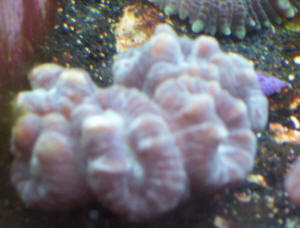
|
Question from GrahamT on Moon Coral -
01/25/07 Fellow crew-members, <<Hello Graham...Eric
here>> This is a coral in one of Rick's service
customer's tanks. He forwarded the pic and here
email to me, and wondered what WWM might make of it. -GrahamT
<<I too have a Faviid displaying this phenomena
(behavior?). The "balloon" will
inflate/deflate periodically. My first thought was
asexual reproduction...but it has persisted for about a year now
with no indication of separating from the "mother"
colony. Maybe Rick's impression of trapped gases
(perhaps from photo-inhibition or over-saturation of gases within
the water column) is closer to the truth. Either way,
other than the often flaccid appearance the affected tissue on my
specimen does not seem to be damaged and the coral continues to
feed/grow/exhibit good health so I'm doubtful this is anything
of much concern. Cheers, Eric Russell>> <To RMF
this looks like an encrusting Brown (Phaeophyte) algae... like
Colpomenia... which can display the mentioned expansion/contractile
behavior. Might be... and has taken up residence on a damaged area
of this Faviid> --------- Graham, I have never seen anything
like this. What do you think? I think it may be a bacterial problem
resulting in trapped gases. What does wet web
think? Rick Rick, We have something weird going on with
our moon coral. One side of it has ballooned out, is
this how they enlarge? It looks like it's full of
air, but it feels more squishy when you touch
it. Otherwise, it looks healthy. It's
been like this for a couple of weeks now. Have you ever
seen anything like this? Thanks,
Lisa |
|
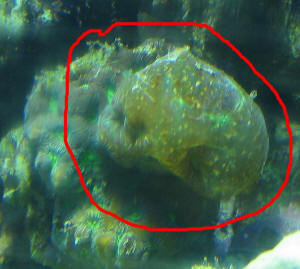
|
| What is wrong with my brain coral?
1/20/07 Hello, I purchased this brain from my LFS about 2.5
weeks ago. Since then he has gone from beautiful to
this. I know the pictures are poor quality and flared (cell phone
my digi cam died yesterday). Hopefully my description will suffice,
He seems to be growing brown algae <Mmm, perhaps a/the
"Jelly" disease of Scleractinians... or maybe just an
algae taking residence on an opportunistic (decomposing)
circumstance> on his ridges, and seems to be excreting these
white fibers, both from his mouths and from the ridges (they are
not long and stringy, they look balled up). <Stress...
mesentery...> He is in a 30 gal <Not easy to keep small
volumes stable...> with a 175w MH and sits on the
sand(~12-14" from the light). <Is this similar to where
this colony was previously?> Also, my nitrates are HIGH, <How
high is high, sigh...> and I have been battling to get them
lower (I Have a refugium being setup as we speak, <"First
comes love, then comes..."> I'm waiting for the miracle
mud to settle) any ideas what to do in the mean time?, <Move
this organism to a better situation... system> also all of my
other corals seem happy as can be (tree leather, Zoos, star polyps,
candy, brush coral). <... In thirty gallons of water? These are
the winners... the new colony, a loser... Allelopathy very
likely> I have been reading and saw somewhere that bristleworms
might be part of the problem?. <Highly unlikely...> I more
than likely have more than should ever be in any tank this size.
<Bingo> I would appreciate any help I could
get. Thanks guys and keep up the good work. -Jason
<Read re Faviid Systems, Disease, Cnidarian Allelopathy (under
Compatibility) on WWM... and soon. Bob Fenner> |
|
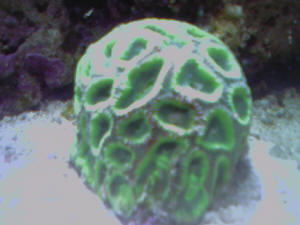
|
| Re: What is wrong with my brain coral? -
Update 1/20/07 Hello Again, I managed to get a
better picture with my phone, along with a short video (should play
with QuickTime) which shows what is going on better.
-Jason <Start here: http://wetwebmedia.com/marine/inverts/index.htm Scroll
down... Read. Bob Fenner> Re: What is wrong with my brain coral?
1/21/07 Hello, I just wanted to ask a couple more questions, you
had stated that allelopathy was very likely I was wondering if this was
a possibility even though the closest other coral to him are the white
star polyps at ~8-10"? <Yes... chemical can be as profound as
physical contact> And yes I do know I should have waited until my
parameters were in check before adding him to the tank, it was my
fiancés impulse buy (never again with something as delicate as
coral/fish). Also, this is only occurring on 1/4 of his
surface area at most. I have read that I should probably put that part
of him in a darker area (to promote healing , if possible) as it
currently gets pretty direct light. Yes it is in a similar
location a to where it was at the LFS, possibly a couple of inches
closer to the light in my system. It doesn't really look
like jelly disease. Also, when he opens up at night, more mesentery
fibers become present, as the day progresses, with current etc, they
blow off. <This is a natural behavior, time frame>
I'm not sure if that is relevant but figured I would
include it. Thanks again for all your assistance through my
idiotic decisions. -Jason <Patience and observation are your best
tools here. Bob Fenner>
|
Sick Candy cane? 12/30/06 Hello
and thanks for reading my question. <Hi there! Mich
here reading your question.> I have a teal candy cane coral that
is showing signs of tissue regression. The polyps
themselves look fine, but the tissue is receding from the base
drawing closer and closer to the actual polyps leaving
the skeleton exposed at the base. My water parameters
are as follows: salinity 1.025 temp 79-81 pH 8.3 nitrites 0
nitrates <5 <How are your calcium levels? I
suspect this might be part of the problem. I see a
Yellow Leather (Sarcophyton elegans) in the
photo. Sometimes you will also see evidence of
unhappiness related to allelopathy. Candy Canes
(Caulastrea) typically lose the chemical warfare
battle.> For lighting I have 2 65 watt actinics and
a 150 watt MH. The coral is located about midway in the
tank. I add Phytofeast and Cyclop-eeze about twice
a week. Is there anything I can do to help this
coral? <Test your calcium level. You might try some
direct feedings also. Caulastrea usually will respond to
meaty foods such as Mysis shrimp, even small pieces of scallop,
fish or shrimp. Be sure to turn off you circulation
before feeding. They will engulf pieces up to the size of a grain
of rice with ease.> It is the bluish green one
in the center of the photo. Thanks for your help.
<Welcome. Good luck! -Mich>
Angela |
Re: Sick Candy Cane part 2 12/30/2006 Dear
Mich, <Hi Angela, Mich here again.> Thanks for your reply.
<You are very welcome.> Should I try moving the coral further
away from the yellow leather or is the effect of the chemical
warfare the same for all places in the tank? <It
will in theory be more concentrated closer to the source, in this
case the leather, but will obviously circulate throughout the
tank.> Should candy canes not be kept in
the same tank as yellow leathers? <They would do better in
different systems.> My calcium is at 400...I do not add calcium,
but I do weekly water changes with Tropic Marine Pro Reef
Salt, so my calcium level seems to stay stable.
<Your calcium levels are fine.> I looked more closely today
and the polyps showing the most regression are those on the lower
side that get the least amount of light. <This could
be the cause.> Should I move the coral further up in the tank or
angle it differently? <I would try angling it
first.> Thanks so much for your help. <I think
you helped yourself. -Mich>
Angela |
|
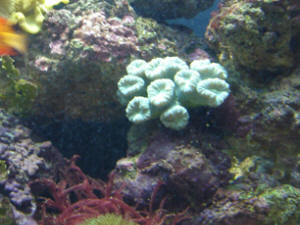
|
Strange encrusting coral... actually strange lack of
info. query 11/6/06 Hi, Newbie here. Not real good at
maneuvering the site yet, but I checked everywhere I thought
appropriate, both on WWM and internet, and could not find an answer. I
will not bore you with complete tank set up for ID question. I have a 4
month old Fox Coral, <The Euphylliid?> that started a few weeks
ago recessing. It gets fed regular and seemed very happy with its tank
location Med flow and high in the tank under 40 watt PC. I looked
closely and found what appeared to be a brown flatworm. I think, I have
finally located enough photos to say this is some sort of Cyphastrea
ocellina or crusty star coral. <?... the Faviid?> It is tan in
color. I can find photos, but no information on this thing. It seems to
be growing very fast. Does my conditions seem favorable for such coral?
<Which? Actually your lighting is a bit low for either> Is it
harmful to my fox? Is it LPS, SPS, or what? <What? The Faviid? See
WWM re...> Should I try and remove it from the fox coral and if so
how, or.......is the fox going to die (skeleton exposed) and I should
let it have the space for encrusting? Thanks in advance for your
help. Cindy
<... Where is information re water quality? Maintenance, feeding?...
Please... read what is archived on our site for these species. Bob
Fenner>
Rare Faviid?/Repeat Post? - encrusting... 11/07/06
Hi, Newbie here. <<Hi Newbie!>> I am not real good at
maneuvering the site yet, but I checked everywhere I thought
appropriate, both on WWM and the Internet, and could not find an
answer. <<Ok>> I will not bore you with complete tank
set-up for ID question. <<...?>> I have a 4-month old Fox
Coral, that started a few weeks ago recessing. It gets fed
regular and seemed very happy with its tank location, medium flow and
high in the tank under 40 watts PC. I looked closely and found what
appeared to be a brown flatworm. I think I have finally located enough
photos to say this is some sort of Cyphastrea ocellina or crusty star
coral. <<Interesting>> It is tan in color. I can find
photos, but no information on this thing. <<Have you seen
this? http://whelk.aims.gov.au/coralsearch/html/401-500/Species%20pages/438.htm
>> It seems to be growing very fast. Do my conditions
seem favorable for such coral? <<Apparently>> Is it harmful
to my fox? <<Will probably "overcome">> Is it
LPS, SPS, or what? <<It is a LPS...in the same family as Faviids
and would need the same care>> Should I try and remove it from
the fox coral and if so, how or...is the fox going to die (skeleton
exposed) and I should let it have the space for encrusting? <<Up
to you, though attempting removal may result in the demise of
both>> Thanks in advance for your help. Cynne <<Very happy
to assist. Eric Russell>> This is the original email,
I sent yesterday. I wasn't sure if you had received it
or not. <<Indeed it was (received)...have you checked the
dailies?>> I appreciate you taking the time to get back with me
on this. <<No problem Cynne...is what we do...>> I was very
careful to check the grammar and spelling before resending.
<<Much appreciated>> I also searched your site, the best
that I could before asking. <<Also much appreciated>> I
have been using your site, for research, for months.
<<Excellent...hope you have found it useful>> I cannot
guarantee I will not repeat a question, or include a typographical
error, but it will not be for lack of effort on my part. <<Is all
we can ask...>> Thanks again for your work here. Your
efforts do not go unnoticed by all. <<Ah, thank you very much for
this...redeeming to know. EricR>>
Re: strange encrusting coral 5/8/06
Hello Bob, <Wayne> Thanks for the reply. My apologies for not
using scientific names, <Mmm, not necessary... but your message just
wasn't clear to me... at one point you referred to a flatworm...
and then asked questions of another hard coral...> I haven't
been at this long. I will check the info. provided for the Faviid.
Water perimeters are all perfect. Nitrates <20, <I would strive
to keep this below 10 ppm> Nitrites 0, pH 8.4, Ammonia 0, Salinity
1.024, Temp 75, I do realize lighting is a little as well as
temperature is a little low, however, I am maintaining a seahorse tank
with mostly gorgonians sponges and soft corals. <Can be done... do
live with these in the wild... as well as many more noxious groups of
organisms> I use an Emperor bio wheel filter system, Red Sea prism
skimmer, and 2 Maxi jet 400 power heads. This is a fifty-five gallon
aquarium and the set-up was designed and maintained with the assistance
of Pete Giwojna <A fine gentleman, "keeper of the faith"
in our interest> from OR, who, by the way recommended I direct most
coral issues to you. Thanks again for your time and I will get the info
I need now in regards to my new found Faviid. Have a great day.
<Thank you for this follow-up. Bob Fenner>
Re: strange
encrusting coral. 5/8/06 Thanks Again, <Welcome>
The flatworm was a reference to the shape of the hard coral.
<Ohhh> I apologize for the confusion. Have you any
recommendations on the nitrates? <Yes... read on WWM re... much
posted re "causes", cures> I currently perform 2-3 water
changes weekly, use a poly filter and nitrate sponge. <Mmm, perhaps
the addition of a sump/refugium, macroalgae, DSB..> I blame it on 2
feedings a day. I can't cut the feedings back, but I am concerned
with the nitrates. I cannot seem to get algae to grow, except the
occasional brown diatoms. When I buy Macroalgae it dies in weeks, My
low lighting perhaps? <Mmm... could be... but might be due mainly to
other influences... Perhaps the already established mix of algae... a
lack of some essential nutrient (rate limiter)... Bob
Fenner
Thanks
Cynne
Re: Rare Faviid? - 11/09/06 Hello, <<Howdy>>
Thanks so much for your help. <<My pleasure>> You were
right on the money with the Faviid description, and without a photo
too, I am impressed. <<Mmm, don't be "too"
impressed <grin>...after all, you did provide the scientific
name>> I guess my fox coral is doomed:(. <<Probably...as
the Faviid grows it will prove to be quite aggressive/will likely
extend sweeper-tentacles to kill the fox coral>> I find this hard
to believe that under such low lighting, not only was the fox coral
happy, but the Faviid showed up as well. <<Many Faviids do very
well under moderate lighting>> I can tell it's growing daily
from the distance it has before actually touching the fox coral itself;
currently it is just growing on the skeletal base. <<Will
eventually overgrow/encrust entirely>> Thanks again. Cynne
<<Very welcome. Eric Russell>>
Candycane skeleton disintegrating
8/22/06 Greeting from Nova Scotia <Hello from San Diego, CA>
I have a small coral reef tank since 9 months that causes
no troubles. One of mine Candycanes got now about 11 branches (had
7 or 8 when we got it) and it's doing really good (dividing,
long tentacles at night, bright colours, etc...). Two days ago
however, I noticed that 2 of the branches are actually disintegrating.
I am talking about the skeleton at the back of the polyp, and
surprisingly enough, the polyps at the end of those branches are
looking awesome and do not seems to be bothered at all. I am
suspecting a lack of Calcium and/or the fact that my pH might be a bit
too low (7.8/8.0) <Could be more...> so it drives
the carbonate equilibrium of sea water toward the HCO3- side but I
am not sure. A friend of mine (has a big coral reef tank) said
that it might be the fact that my Candycane is submitted to water flow
that are two high. <Another factor> I doubt it, but do you
have any suggestions ? Thanks so much in advance Flavienne <Mmm, the
ultrastructure of the alkaline earth skeletal matrix is likely
"missing" something... happens frequently with (your as
stated) imbalance of calcium, magnesium and alkalinity... Do you have
the "Kalk habit"? This is a common situation (soft skeletons)
with this use... other methods of supplying ready alkaline earth,
carbonate produce "harder" bio-matrix (calcium reactors, two
part supplements...). Bob Fenner>
-------------------------------------- Dalhousie University Department
of Oceanography
| Favia brain received in bad condition
7/8/06 Hello again. So I work at a LFS
and on their stocklist has a red Favia brain which sounded
appealing to me and it was rather expensive, so I expected
something great. Well I did not receive anything great,
but because I asked the owners to order it for me I took it and
kissed the cash goodbye. The problem is, it is suffering
from major recession. My question is can it be nursed
back to health, and can it cause any other corals in my
tank to have problems? <Yes, and unlikely, but can add to
overall "stress" for sure> It doesn't appear to be
suffering from any infection, it was probably just in a bad
"holding" tank for a while. To me it just
appears like it was not fed properly or was in bad water. <I
concur> The other corals I have in my tank are: Favites brain,
torch coral, Trachy brain, green star polyps, and some finger
leathers and mushrooms all of which are doing very
well. My water quality is excellent, ammonia 0, nitrite
0, nitrate 0, phosphate 0.1, calcium 400, alk 10 dKH. So
with proper feeding (by the way his tentacles did extend last night
to my surprise) and excellent water will it be ok? <Likely
so> I usually feed finely chopped Mysis to my brain
corals. I have attached a picture which is a little
blurry and from that I hope you can tell me if this coral can be
saved. <Can be... You do administer weekly iodine/ide/ate?>
Thank you very much, Ryan Nienhuis. P.S. I did contact
the wholesaler the coral came from and she said she would make
things right....there not all bad. Once again thank you
in advance for your advise. <Ah, good. Thank you for writing so
clearly, completely. Bob Fenner> Thank you very much for the
response I really appreciate it. If it is OK with you I
will give you periodic updates on the corals
health. Thanks again, Ryan Nienhuis. <Would
appreciate this. Thank you, BobF> |
|
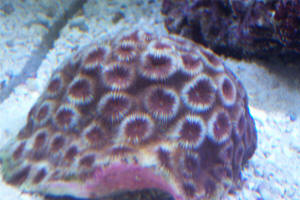
|
|
Re: Favia improvement 7/15/06 Thanks for
the response. Another thing, although the red Favia is
improving I have only seen it's tentacles come out once. <Things
take time...> Any suggestions (tried the juice and
turkey baster trick)? The only time the tentacles came out,
I was fooling around with the powerheads, any idea why this would
trigger such a response? <Yes, improved circulation, oxygen...>
My replies don't seem to be getting through to you but
I will try again. Hopefully I will not bother you for a
while with any more questions. Thanks again, Ryan Nienhuis.
<Welcome. Bob Fenner>
Re: Favia brain update 7/23/06
Hello again. I told Mr. Fenner I would keep
him updated on a Favia brain I received in absolutely terrible
condition. It has improved greatly over the past couple
weeks and is now opening its tentacles at night so I can feed it.
<Ah, good> The color is coming back and the
recession is slowly fading, although still evident. I do
have a new question, I have read the article on your site about
Aiptasia and I have a reproduction crisis. The dumb
things are going crazy. Little babies are floating in
the tank...what do I do? <Your options are posted on WWM as
well...> It seems the more I try to kill the more they reproduce
(@#$%). It could, and probably is a result of
overfeeding, trying to save the coral and get the new fish to eat.
<Very likely nutrient abundance is a factor here>
My water parameters are excellent which leads me to
believe nutrient export is good. <... Or...
imagine... that nutrient uptake is excellent... eh?> I also have
a issue with a Kole tang harassing a newly purchased blue
flavivertex Pseudochromis, it does not appear to be
trying to hurt it, just chasing it which makes it hard to
feed...any ideas? <If not apparently harming
it...> By the way my water parameters are ammonia 0, nitrite 0,
nitrate 0, calcium 400 ppm, alkalinity 10 dKH, phosphate 0.1, and
pH 8.3. Tank is 90 gallon with 20 gallon (half full)
sump and aqua c remora pro skimmer. Tank inhabitants
Kole tang, false percula clown, blue flavivertex Pseudochromis,
cleaner shrimp, Montipora, Acropora, Trachy brain, Favites brain,
Favia brain, green star polyps, torch coral, several
mushrooms, finger leather, several unpurchased green sponges,
Trochus snails and a queen conch. Sorry if this was a
little lengthy didn't want to leave anything
out. Thanks very much, Ryan Nienhuis
(again). Oh yes by the way I have included pictures of
purchased Favia before and a couple of weeks after. <Thank you
for this update. Bob Fenner> |
|
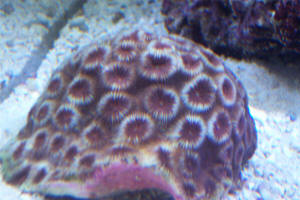 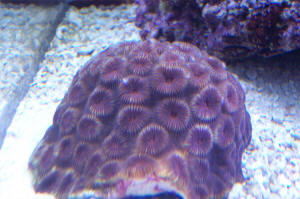
|
Green open brain necrosis 4/14/04 First off: this site is
incredible! You guys are one of the best resources I've found yet
(still new to the hobby though). <Thanks for the kind words!>
Anyway regarding my problem, I searched & browsed the site/FAQs,
and got some good info, then tried the public forum, but no
responses, so here goes. In a nutshell, after being out of town for 5
days my open green brain is suffering serious tissue necrosis which was
not at all evident before I left. <You will find that one of the
amendments to Murphy's Law states that these things will always
happen when you are out of town.!<g>> This is a new 37 gal
tank (2 months old), but the brain was doing quite well before I left
town (already in the tank for 1 month, bad advice from my
LFS). When I returned from my trip everything in the tank
looked fine except for the brain, which showed a small area of what
looked like irritation (bright green spot, slightly dented-in looking).
Today it's blossomed into full-blown tissue necrosis across one
lobe. I lifted up the brain (from the base, using a glove) and upon
closer inspection the affected polyp tissue looks like it has some tiny
holes bored into it--like termite holes in wood. <Open brains are a
bit more sensitive to water quality than most folks consider them to
be. They are also one of the corals most commonly picked on
by fish. Their fleshy inflated tissue can be easily
damaged.> Here are some possible culprits/factors: (1) a few days
before I left town I added new cleanup crew members, an assortment of
snails (Astrea, Nassarius, Ceriths) and some small blue leg hermits.
Could these be doing damage? I've seen them waltzing through the
button polyp but never anywhere near the brain. (The button polyp and
finger leather are a good 18" away from the open brain, which is
on the sand with decent light exposure and moderate water flow (no
direct laminar flow)). <It is possible that the hermits damaged the
brain, but unlikely. Any fish that may be nipping?> (2)
the inverts had been added to battle green hair algae which started
blooming a week or so prior. I set up the tank with dechlorinated tap
water but have been using RO/DI for about 3 weeks now. So there are
probably still some phosphates in the tank. I just read a reference to
boring green algae on your site but didn't find much info on it.
I'm guessing this is unrelated to run-of-the-mill nuisance algae
but that's a newbies guess. The tiny holes got me thinking.
<Such boring algae are quite rare, but conspicuous when
encountered. The real issue is that when exposed skeleton
becomes colonized with algae, the coral has a hard time overgrowing
it.> (3) While I was gone the house sitter only topped off water
with my RO/DI supply, but I think the weather was hot: when I got back
the water level was low and specific gravity had shot up to like 1.027
from the normal 1.024. This would have been for 2-3 days at the most.
<No concern over the rise in SG.> (I performed a 10% water change
and brought the salinity down to 1.025, then 1.024 the next day. All
other tests were not that remarkable--ammonia, nitrite, nitrate were
zero, pH 8.3, temp. 77, alkalinity 3.5 meq/L). <Keep in mind that
drops in salinity are far more stressful to inverts than
rises. Water quality sounds fine.> (4) I have never fed
the coral in the 4 weeks I've had it (more bad advice from the
LFS). I just fed the poor guy some minced fresh shrimp per guidelines
found on your site. <Great! Pieces up to the size of a
marble or so should be greedily accepted.> (5) A week or so ago I
moved the coral to the corner of the tank, as in its previous location
it was growing upwards into a rock overhang and I was afraid it would
get an abrasion. The new location should be getting plenty of light but
it's possible water flow is weaker in that area. Even so, would
that cause tissue necrosis? <Perhaps you are seeing the effects of
previous damage? Open brains prefer moderate current, but
are very tolerant of fairly low current.> Thanks for any advice. I
have pics if that would help but it basically looks like the green
brain 2/3 of the way down this page, but worse:
www.wetwebmedia.com/corldisfaq2.htm Your fan, John MB <My
hunch is that there was some damage, and the coral was not able to cope
because of the immaturity of your tank. There are no
measurable parameters that suggest maturity, and it is a very
non-specific term. Suffice it to say that corals do better
in systems that are at least a few months old. Best
regards. Adam>
| Brain Polyp Bailout - stress
induced 2/8/04 Dear Anthony, See photos attached of a massive
polyp bailout and a new brain coral starting life from
bailout. I get a bailout from the big coral about every
three weeks or so and several have "taken root" on nearby
rocks. Can I continue to make more small brain corals in this way?.
Any way to make a "bed" for the bailout to plant in?
Howard <polyp bailout is usually a stress induced reproductive
strategy and weakly successful in aquaria in the long term (the
donor will likely die in time if not rescued). Looking at the
pictures you've provided... the source of stress is clearly the
encroaching Zoanthids which are (chemically) fiercely aggressive.
Your brain "knows" its days are numbered... likely to be
killed within a year if the Zoanthids continue. As to the polyps
themselves... yes, they can be saved/viable but are not inclined to
be fast growing or particularly successful sitting in the same
tank/water that caused the polyp bailout of the parent. Its a very
good rule of thumb to maintain a minimum of 10" between all
corals... and be sure to use carbon or some other chemical
filtration regularly (changed weekly in small portions). Large
weekly water changes and zone use too will help temper allelopathy
causing these issues/bailout. Best of luck! Anthony> |
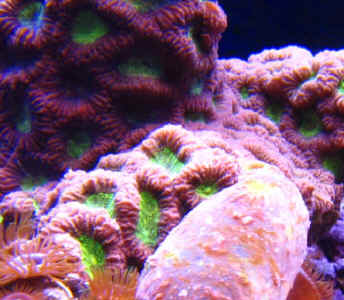 |
 |
| Losing His Brain? (Brain Coral In Trouble?) Wet Web
Crew, <Scott F. here today!> Hello all! Let me
take a moment to suck up.... You
rock! I've learned a ton from your site, and always
check there for any questions I have. Great
resource! Thank You! <No need to "suck up!"
We're all fish nerds, just like you! Well, maybe a bit more
weird, but nonetheless harmless!> This is a coral I recently
ordered. (I've included a current picture along with
the one from the site I bought it from ... I'm guessing you can
tell which is which?) <Doh! I couldn't open the attachment,
so I'm not able to make an ID for you here...Grr> Prior to
this, I've purchased all my coral from local shops, but I
haven't been able to locate a maze brain, so I gave mail order
a shot. What came was, well, less than ideal. Is there
anything I should do to try and nurse this coral back to health?
<Unfortunately, common names for coral are not much help, as
many different coral species can go by this moniker. Let's
assume that we're looking at a Platygyra or Leptoria, the two
most commonly found species to carry this "Maze Coral"
name...Well, Leptoria is extremely rare, but misidentification is
not uncommon! Anyways, Platygyra can bleach pretty easily if it is
injured, or if conditions are not to its liking. Often, they are
collected intact, which makes the chances for survival and growth
much higher. If the specimen has been damaged by hammering it off
of the reef, the coral will have a much tougher time adapting to
captivity, and resisting disease. My best advice for an injured
Faviid coral would be to provide clean water, moderate to strong
water flow, and bright lighting (once the colony has acclimated to
it, of course). Keep the coral away from "pickers", like
Centropyge angelfish, and do offer fine zooplankton foods, such as
Cyclop-eeze or Liquid Life "Coral Plankton". If you see
necrotic tissue, be sure to remove it at once. Try not to disturb
the damaged coral excessively, if possible.> Can you estimate
it's likelihood of survival? <If you can stop any advance of
necrosis or bleaching tissue, it's chances of recovery are
probably pretty good...Only time will tell> You'll note the
attached text, also. It includes a description of the
coral's condition. I have yet to hear back from the
shop. Mickey <Sorry again that I couldn't get the pic,
Mickey. I hope this general information was of some use, though.
Good luck! Regards, Scott F.> |
|
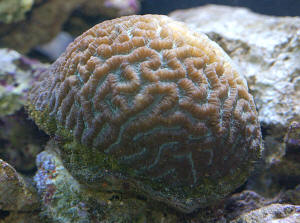
|
Candycane dying Hey guys, <Nilesh> I have 155 gal new
tank established for the past 4 months with live, skimmer, 4-802
powerheads, 175 watt venture MH bulbs. I bought
this tank second hand and inherited a Candycane coral.
<Okay> For a while, about 2 months the coral was doing fine but
lately I've noticed that the coral is bleaching. Also
the green pigmentation, I guess Zooxanthellae sort of split
open. Is this coral dying? <Doesn't sound/read as if
it is well> Can I save it? <Probably> All my parameters are
normal... salt, pH, ammonia, nitrate, nitrite, temp. The
coral is placed in medium depth, no direct lighting, and medium
flow. I haven't really spot fed the coral...I thought
that the light would provide enough food. What do you think?
<Lighting is not a sufficient source of nutrition for this
species... a healthy refugium might supply other food... but...> The
calcium may be the problem, it's 280. I know that this
is low but I'm having a hard time maintaining it at
400+. I don't have a calcium reactor, so I've
been using Tropic Marin's Bio Calcium with trace
elements. Do you think that the low calcium/trace element
level is causing the death or lack of growth? <Definitely is
contributing to the poor health> Since it's a new
set up, I.e. it's still going through those awful algae
phases...I'm at Cyano right now and the coral has quite a bit of
hair algae on it. I've tried to blow it off with a
powerhead. it works but comes back... is this preventing the
Zooxanthellae from taking in light? <Among other
ill-effects> Last question, I'm wondering why my levels of
calcium has fluctuated from 400 to 280 in 2 weeks. I've
been doing 5% water changes and have been adding calcium. I'm
guessing that the calcium is used up for coralline algae growth
although I don't see any coralline at this time. Pleas
help...Any info would be appreciated Nilesh <These questions and the
next several sets that you will have are posted on WWM... please take
the time to read what is posted there re your species health,
environment, feeding... calcium... And soon. Your system will fare
better with your knowing what you're about here. Bob Fenner>
Re: Candycane dying Hey guys, One
more addition to the info which I left out. I had a pink tip
anemone in the tank which got crushed when a rock fell over
it. I wasn't sure if it was going to die so I watched it
for a day. The next day, it stunk! I immediately
threw it away. Do you think that the anemone released toxins
or waste that killed my Candycane? I've tested the
ammonia and it is less than 01. The cane
started dying a day later... Nilesh <Definitely could be
related... again, please stop spending your money experimenting... and
read/study... these organisms cannot be successfully mixed, placed near
each other. Bob Fenner>
Brain coral <Hello EAM917> We have a
46 gal reef tank which has been working for approx 7
months. A few months ago we got a green brain
coral. It would change size during the course of the day and
evening. Usually large during the day and much smaller in
the evening.<Sounds normal> During the past 3 or 3 days it has
not changed size, it is small. The sides appear to have some white
coloring which we have not seen before.<Sounds like bleaching> Do
you have any idea what is happening and what we should do.<Several
factors can cause this. First, what kind of lighting are you
using? Do you feed your corals? The hard corals
of which the brain is a member of require very intense lighting of the
proper spectrum to survive along with good water movement. Answer the
questions I have asked and we can try to help you. James (Salty
Dog)>Thanks Elizabeth
Re: Brain coral, health Thanks for getting back to me so
quickly. <You're welcome Elizabeth> We have never heard of
bleaching, what is it & can it be corrected?<In a
nutshell bleaching occurs when things are not to the corals
liking> We use a coral life Aqualight double strip 34 in
96 w Actinic and 96 w 10000k square bulb. Water movement in
the tank is good. We are using flake food for the fish and
were never told by the store to use anything else. They said they would
get their food from this. Do you think this coral can be saved.<What
is the height of your tank? The PC lighting may not be
intense enough for the brain coral. Corals don't require
feeding on a daily basis but a weekly feeding is
good. DT's phytoplankton is a good choice. As far as
saving the coral, keep your lights on for 12 hours, replace the bulbs
if they are over one year old, do 10% water changes weekly. There is no
cure in a bottle that will save corals, just good sound maintenance of
the aquarium is all you can do for now. James <Salty Dog)>
(Thanks Elizabeth
Re: Brain coral, health My husband said to tell you that the
nitrite and ammonia is 0ppm however the nitrate is over
160ppm. Would that stress it.<yes, corals do require
pristine water quality. This tells me you do not do 10%
weekly water changes. This helps reduce the nitrate level by
dilution.> He has put in a nitrate sponge<the nitrate
sponge is fine but nitrates have to be controlled at the source of the
problem or the levels will just return>in the filtering system to
try to lower it earlier today and did a water change 6 days
ago. The water temp is 78. Thanks Elizabeth<James (Salty
Dog)
Re: Brain coral We have done 2 water changes and the levels
are still high. Any suggestions to lower it. I
was wondering, parts of the brain are looking better and are enlarging
during the day. You can see them moving or pulsing like
water is going through them. I don't know what actually
causes that. Other parts seem to have split open
and you see an off white color that appears skeletal. Is
there a possibility that parts will continue to live on the brain coral
or is it just a matter of time before the entire brain changes to
white. If this happens is it dead ? Thanks
Elizabeth <Elizabeth, if you have a canister filter I would
recommend you get some "Chemi-pure" and use
this. It is an excellent product for removing nutrients in
the form that protein skimmers will not take out. You do
have a protein skimmer, correct?. James (Salty Dog) Re: Brain coral
part 2 Sorry the mail somehow was sent. I am bad on the
computer. We did a water change again last night. The brain
is enlarging during the day but only is some sections., We
can see is moving or pulsing like water is going through
it. Some parts seem to have split open and you see an off
white color that appears skeletal. Is there a possibility
that parts will continue to live on the brain or is it just a matter of
time before the entire brain changes to white. If this
happens is it dead. Thanks Elizabeth <Hello Elizabeth,
One thing you have to keep in mind with keeping hard corals, or
anything marine for that matter is that weekly water changes (not just
till things get better) is one of the best things you can do
for the overall health of the tank. It not only removes
nitrates etc. by dilution, but also replenishes traces elements that
have been absorbed by the animals. You will know when the
brain is dead. You will end up with a white
skeleton. These corals are not one of the easiest to
keep. The elegance or bubble corals are a little easier to
maintain. James (Salty Dog)
Re: Helping injured brain coral 1/12/04 This is for James,
Salty Dog. You have been helping me with a problem with the
46 gal reef tank. I was just wondering if a brain coral
could still live when a portion of it is damaged or will it eventually
die? <Anthony Calfo with a contribution as well :) indeed, most any
can survive and recover with adequate water quality (do not move the
animal and stress with a change in light... provide good turbulent
water flow but never laminar, etc.). The addition of small amounts of
iodine (reef supplement) may be of some indirect benefit too. Feeding
the coral with tiny bits of food (Mysids or Pacifica plankton...
nothing larger) will be of tremendous help! 3-5 times weekly. Best of
luck, Anthony>
Helping injured brain coral 1/12/04 This is for James, Salty
Dog. You have been helping me with a problem with the 46 gal
reef tank. I was just wondering if a brain coral could still
live when a portion of it is damaged or will it eventually die?
<Anthony Calfo with a contribution as well :) indeed, most any can
survive and recover with adequate water quality (do not move the animal
and stress with a change in light... provide good turbulent water flow
but never laminar, etc.). The addition of small amounts of iodine (reef
supplement) may be of some indirect benefit too. Feeding the coral with
tiny bits of food (Mysids or Pacifica plankton... nothing larger) will
be of tremendous help! 3-5 times weekly. Best of luck, Anthony>
Moon Coral Anthony, <cheers> I purchased Favia (moon
coral) a week ago and have started to notice the lower edges of it
starting to turn brown. <many possible reasons for this... are
your nitrates a bit high by chance?> It is placed on top of the LR
about 10" from the surface. Lighting is 3; 250 watt MH with 6500
Iwasaki bulbs, and 2 160 watt VHO, located 10" above the tank. I
have Sprung's book on Coral and used his reference chart to locate
the coral. <although I generally do not recommend 250 or 400
watt halides to most aquarists unless they are keeping SPS or clams,
Faviids are generally high light creatures and I'm comfortable with
your choice of placement> Flow is directed almost directly across
it. <laminar flow can be stressful... do adjust to surge or
random turbulent if possible, else watch for stress or tissue
erosion> All my other corals are fine, water quality and temp are
text book. <what book? :p> Thanks, Mark Johnson <my
preliminary opinion is that it is an inevitable but acceptable
acclimation to the new lighting scheme. The fact that this color change
is not a paling shift indicates a possibly favorable (health of coral,
not necessarily aesthetically pleasing) acclimation to me. Best
regards, Anthony>
Does my Brain (coral) need help? Hi Crew
! You've been great help in the past so lets try it
again. <Glad you have benefited!> Presently have a 46 gallon bow
front with roughly 90 lbs of live rock and assorted healthy fish.
Tunicate and sponge growth here and there. I would think this is a sign
of a healthy tank also. Lighting consists of one Coralife 10k and one
Hagen Marine-Glo actinic staying on 9 hours per day. Good filtration
and moderate skimmer. I am a believer in Tom Walsh's theory that
you don't have to have a complex system to be successful in this
hobby just good husbandry. <All sounds reasonable. I do
also subscribe to the KISS principal... Keep It Simple Stupid!> Now
to my question. I was given a Green Closed Brain Coral two weeks ago .
I have never kept corals before but have read that the Favia? was a
good beginner. I have noticed that in the last week it is showing some
brownish coloring around some of the edges. <A picture is worth a
thousand words here.... This is most likely "browning
out" due to differences in (likely less) light in your
tank. If the tissue looks in tact, but is just changing
color, I would not worry.> I have always used SeaChem Reef Calcium
and Reef Complete but have been out since this coral was added. I dosed
the tank last night and also added Reef Plus. What do you think will
happen now. Will he recover from this? Will the supplements get him on
the rebound? His feeder tentacles are out when the lights come on
however. Thanks for your help. Randy <The only way to be
sure what supplements are necessary is to test for those
elements. My suggestion is to supplement only calcium and
alkalinity (should be checked often), and nothing else unless you are
testing for it. In most cases, regular partial water changes
will supply enough of everything else. Over use of
supplements can easily lead to overdose. Occasional feedings
of finely chopped meaty seafoods will also be of great
benefit. Best Regards. Adam>
|
|

